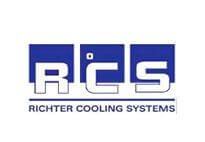Products and systems
in which you can trust
in which you can trust
Things worth knowing about cooling towers and evaporation plants
As is the case in any sector, certain specialist terms exist in the field of recooling technology, stemming for the most part from physics.
Here we provide an overview of the most important terms and definitions.
There are currently 19 names in this directory
The relative air humidity f [%], sometimes also referred to as atmospheric humidity, is the ratio of the partial water vapour pressure actually present in the air to the saturated steam pressure of the water at the current temperature.
Approach a [K] is the difference between the cooling limit temperature (wet-bulb thermometer temperature) and the cold water temperature tw2. Alongside the heat quantities to be discharged, the approach is particularly crucial to the size of a wet cooling tower. It should not be any smaller than recommended in Fig. 1. The following applies: the greater the approach, the smaller the cooling tower.
Atmospheric pressure p0 [mbar] is the static air pressure of the atmosphere, unaffected by the cooling tower.
Cold water temperature tW2 [°C] is the average temperature of the cooled water in the outlet structure, not influenced by the make-up water.
Cooling capacity Q [MJ/s, MW, KW ] Energy flow discharged from the water into the air (heat quantity). Every cooling tower operated within the circulation system, irrespective of size, discharges the total quantity of heat with which it is charged.
Cooling range Z = tW1-tW2 [K] is the difference between the warm water temperature tW1 and the cold water temperature tW2. The cooling range is not determined by the cooling tower, but rather by the heat exchanger assigned to it. The cooling range is dependent on the heat quantity and the mass water flow. Comment: small z = large cooling tower; large z = small cooling tower
The cooling term is used for the cooling of heated water. Inside of the cooling tower the water is evenly dispersed over the cooling installations, and is brought into direct contact with the air. The majority of the cooling takes place by means of evaporation, with a smaller proportion resulting from convective heat transfer.
Droplet expulsion mWS [m3/h] refers to the droplets released at the air outlet. 0.01 – 0.02% in the case of a counter-current cooling tower, 0.03 – 0.05% in the case of a cross-flow cooling tower.
The dry air temperature tL [°C] is the temperature of the air at the dry, radiation-protected thermometer.
Evaporation loss mW0 [m3/h] is the evaporating component of the mass water flow; mW0 » mW (tW1 – tW2) / 600 or ~0.016 mw per 10 K cooling range.
Intensity of rainfall r [m3/m2h] is the mass water flow per m2 of the rained on cooling tower surface.
Make-up water mZ [m3/h] is the water quantity that is fed to the circulation system as a replacement for the water quantity lost as a result of evaporation, droplet expulsion, spray loss, leakage and flow off. mZ = mW0 x n / (n – 1); n = concentration of the permitted salt content (thickening)
Mass exhaust flow rate mwa [m3/h] mZ – mW. As a result of evaporation, the concentration of mineral-based components in the water circulation system increases. In order to prevent the concentration from getting too high, a proportion of the water must be removed from the circulation system. The water flow to be discharged is based on the quality of the make-up water and the permitted concentration in the water circulation system (thickening).
Mass water flow mW [m3/h] is the water quantity fed to the cooling tower per unit of time.
Power consumption Pel [kW] is the electrical power consumed by a machine or engine measured at the terminals of the motor. At the fan shaft, the power is the measured mechanical power.
Power requirement P [kW] is the maximum power consumption of the fans and/or the cooling water pumps.
Theoretical limit of cooling [°C] is the lowest theoretical achievable cold water temperature, assuming infinitely large exchange surfaces. In the case of the wet cooling tower, the theoretical limit of cooling is identical to the wet-bulb thermometer temperature.
Warm water temperature tW1 [°C] is the temperature of the water upon entering the cooling tower.
